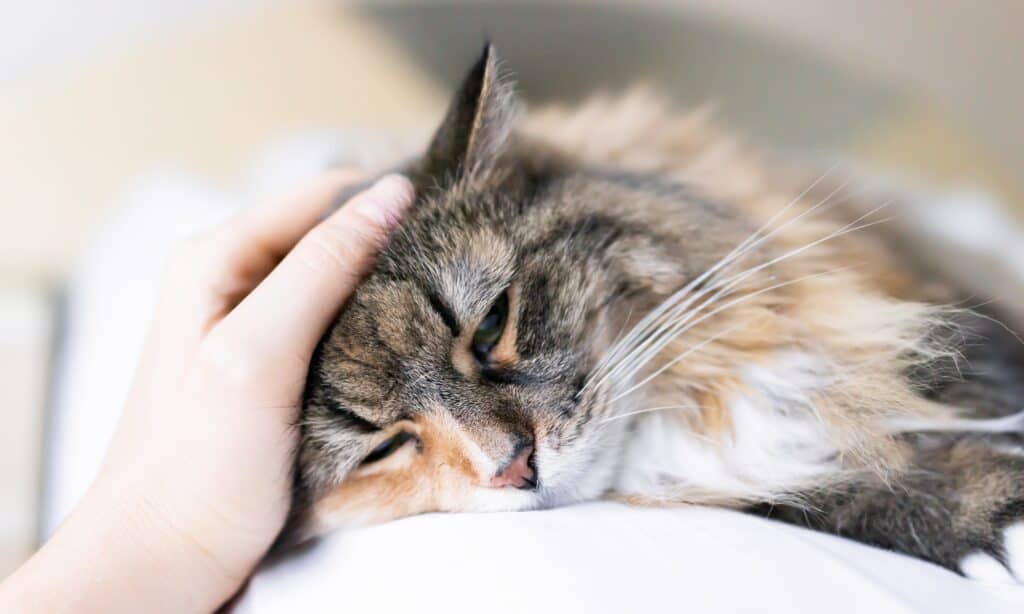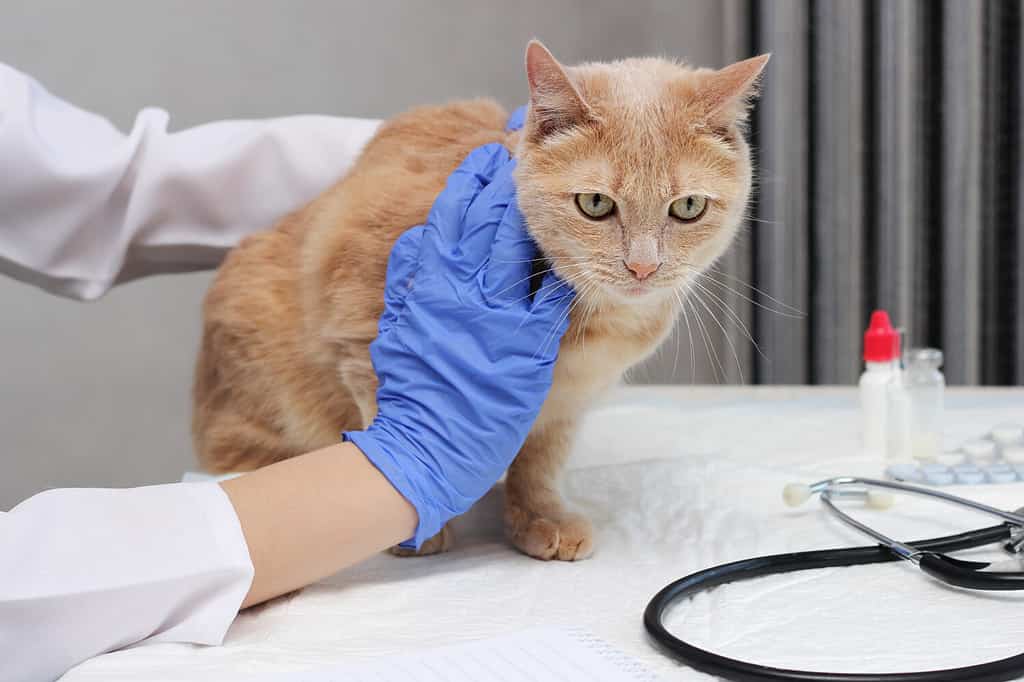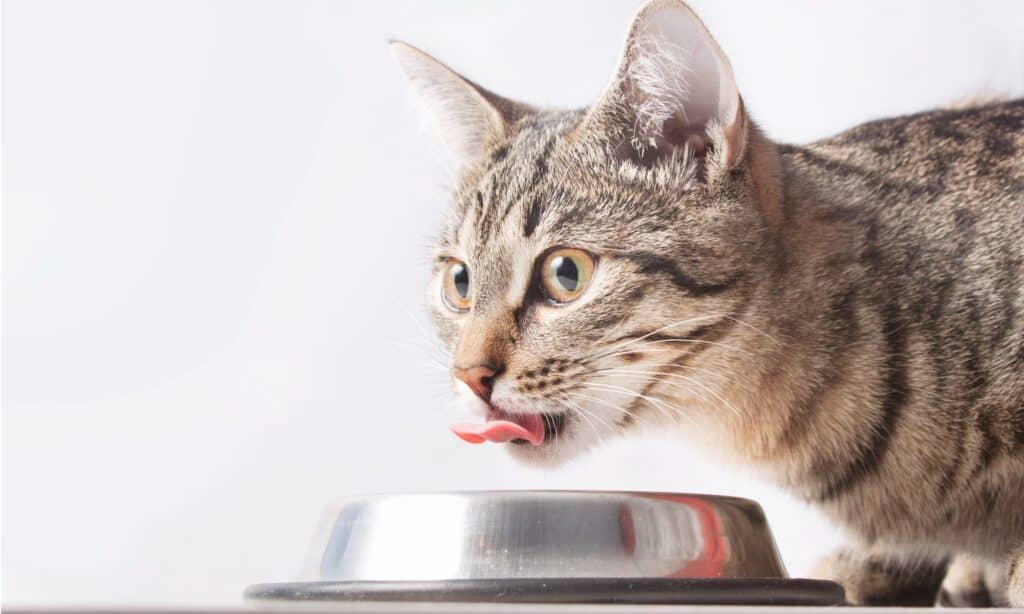Whether you’re going on vacation or you find that your feline friend hasn’t been eating, it’s essential to know how long cats can go without food. Generally speaking, cats can survive for one to two weeks without food. Any longer than that and there could be dangerous consequences.
Does that mean it’s safe for them to go that long between meals? Below we’ll talk about everything you need to know to ensure your cat is okay and their eating schedule stays regular.
How Long Can Cats Go Without Eating?

Most vets will suggest opting for wet food over dry cat food.
©MaraZe/Shutterstock.com
A cat refusing to eat can live up to two weeks without eating, but there would be detrimental effects on its health. Similar to how humans use their fat reserves for energy, cats that are lacking food for three days or more will start to do the same.
However, the primary purpose of protein in a cat’s body is to provide energy. Because they are obligate carnivores, cats need meat in their diets in order to survive. The liver may become overburdened in a cat that stops eating meat for a period of time and starts to use its fat stores. With that, even though a cat may go for extended periods without food, he or she still has to eat each day to stay healthy and have a high quality of life.
Like domestic cats, feral cats require consistent meals, but due to their difficult lifestyles, they may not always be able to get them. If you have a strong interest in helping feral cat colonies, think about working with a nearby organization that provides food and labor in exchange for volunteers.
In the event that your own cat hasn’t eaten for a few days, it’s time to take it to the doctor, as there could be a number of significant health issues causing this. If your cat is just fussy about what it eats, though, you can try heating its meal, mixing a little wet cat food with the dry, or perhaps testing a different food to see if that helps.
Why Isn’t My Cat Eating?

Your cat may not be eating due to an internal issue that requires medical attention.
©iStock.com/krblokhin
It’s a well-earned stereotype that cats are picky and unyielding eaters. If you find that your feline friend isn’t eating, here are a few common reasons.
Internal Issues
One reason they may not be eating is because they are experiencing diarrhea due to an improper diet or eating an item they shouldn’t have. Tumors and other foreign bodies that can trigger vomiting or diarrhea are additional potential causes of digestive issues.
One of the many prevalent diseases in cats that makes them not eat, especially in older ones, is kidney disease. They don’t eat when experiencing painful kidney issues. Feline gastrointestinal symptoms may also make it challenging for your cat to consume food.
Change in Environment
It’s possible that your cat’s environment has changed recently, causing them to stop eating. Did you just move houses? Perhaps you brought a new furry friend home. Even rearranging a room can throw off a cat’s eating schedule.
It might be necessary to gradually alter your cat’s diet by providing new foods to them a little at a time. In addition, a shift in your cat’s daily routine at home could make them stressed, anxious, or depressed, which would make them quit eating.
Dangers of Your Cat Not Eating Enough

You should bring your pet to the vet if it’s been more than two days since they last had food.
©YULIYA Shustik/Shutterstock.com
Your cat requires food and water to survive, so without these necessities, the cat is at risk for major health issues. For instance, you might be extremely worried and visit the veterinarian if your cat is still refusing to eat after a day or two.
Their liver might not have failed entirely yet, but it might be getting near. The more time passes without food for your cat. the greater the harm to its body. Rehabilitation consequently becomes more difficult.
Don’t be reluctant to get help; do it right away. Severe medical issues such as nutritional deficiency, fatty liver disease, and dehydration can develop if appropriate care is not received.
How to Encourage Your Cat to Eat

Sometimes pet owners need to rearrange the contents of a cat bowl due to whisker fatigue.
©iStock.com/Ukususha
You can try a few different things in order to determine if your cat starts to eat again. Serve them food that has been canned or is moist. A rule of thumb for this is the stinkier the food is to you, the more enticing it is to your cat.
Also, make sure that your pet’s food dishes are cleaned regularly. Avoid plastic dishes, as these can cause allergic reactions. Cats prefer stainless steel. Plus, this material is the easiest to clean! If you only have kibble, consider soaking it in a mixture of water and tuna juice from a can.
Because of the sodium content of the tuna, make sure to add plenty of water. Of course, always check in with their vet to rule out any internal problems that could result in your cat’s eating habits changing.
The photo featured at the top of this post is © osobystist/Shutterstock.com
Thank you for reading! Have some feedback for us? Contact the AZ Animals editorial team.







